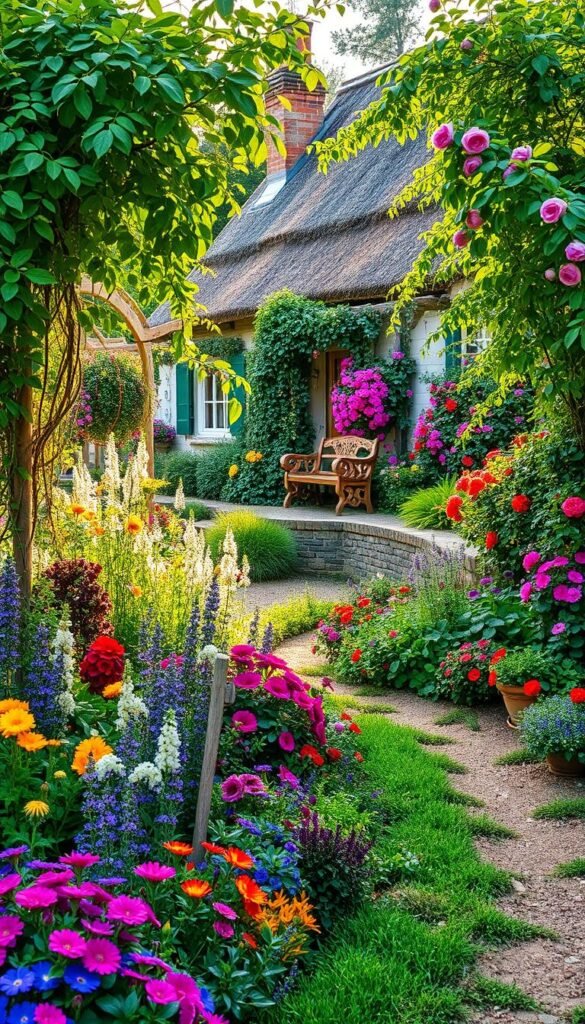Imagine stepping into a space where vibrant blooms mingle with fragrant herbs, and winding paths invite exploration. Unlike rigid, formal layouts, this style embraces flowing curves and a joyful mix of colors and textures. It’s not just about looks—these spaces blend beauty with purpose, offering fresh ingredients and a peaceful retreat.
Creating such a sanctuary starts with understanding its core principles. Curved beds and natural materials replace straight lines, while dense plantings create a lush, layered feel. You’ll combine ornamental varieties with edible favorites, ensuring every corner serves both eye and table.
Success hinges on thoughtful preparation. Testing your soil and enriching it with compost—like the recommended 30% blend—sets the stage for thriving growth. Pair this with smart strategies, such as grouping species with similar water needs, to minimize waste and maximize health.
As seasons shift, so do your priorities. Simple tweaks, like seasonal adjustments to planting schedules, keep your space productive year-round. Whether you’re harvesting summer tomatoes or pruning spring blooms, each task connects you deeper to nature’s rhythms.
Ready to transform your outdoor space? Let’s begin with the essentials—designing, selecting greenery, and nurturing your vision into a living masterpiece.
Welcome to Your Dream Cottage Garden
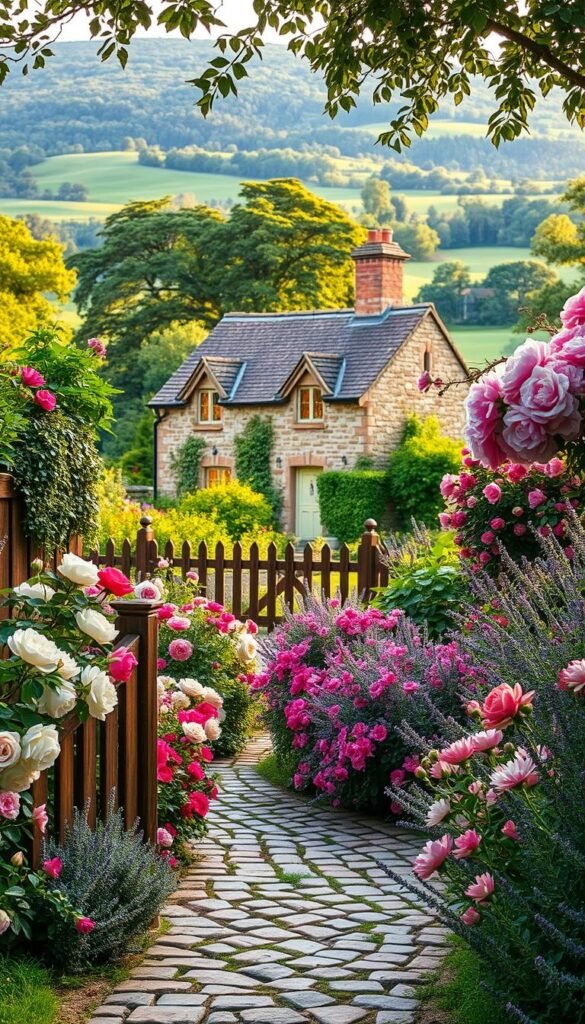
Step into a realm where nature’s artistry meets your personal haven. Here, wild beauty blends with intentional design, creating spaces that feel both spontaneous and purposeful. Meandering pathways guide you past fragrant herbs and cascading flowers, while weathered stones add rustic character.
Discover the Charm of Cottage Gardens
These spaces thrive on contrasts. Delicate roses climb beside sturdy vegetables, and bursts of color frame quiet nooks perfect for reflection. You’ll gather fresh mint for tea just steps from where butterflies dance around lavender blooms. It’s a living tapestry that nourishes body and soul.
Understanding the Informal, Whimsical Style
Forget rigid symmetry. Cottage gardens celebrate joyful imperfection. Plants spill over edges, creating layers that shift with the seasons. A bench tucked under an arch becomes your outdoor living room, blurring the lines between home and habitat.
| Feature | Cottage Gardens | Formal Gardens |
|---|---|---|
| Layout | Curved, flowing lines | Geometric patterns |
| Plant Variety | Mix of edible + ornamental | Single-species beds |
| Maintenance | Relaxed pruning | Frequent trimming |
This style invites creativity. Let morning glories scramble up a trellis one year, then try sweet peas the next. Each choice adds to your garden’s evolving story—a testament to nature’s resilience and your unique vision.
Starting Your Garden Layout: From Lawn to Lush Landscape
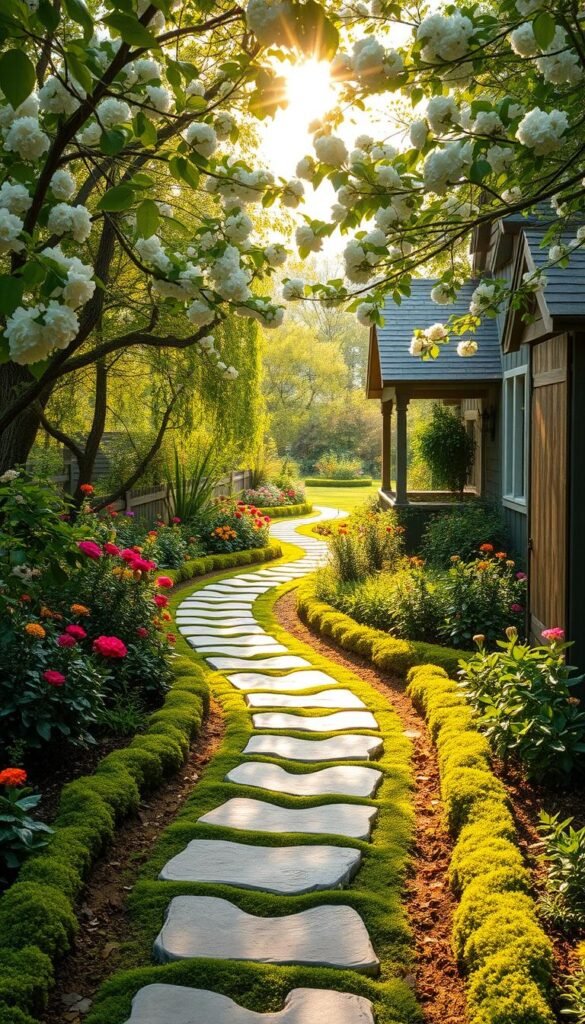
Transform your outdoor area into a dynamic tapestry by embracing nature’s curves. Unlike traditional grids, flowing lines invite discovery while maximizing visual depth. This approach turns empty lawns into immersive environments where every turn reveals new delights.
Curved Walkways: Where Function Meets Enchantment
Soft bends in your pathways create natural pauses, encouraging slower exploration. Whether using weathered bricks or crushed gravel, focus on gradual arcs that hide partial views ahead. “A well-designed curve,” notes landscape architect Mara Thompson, “whispers invitations rather than shouting directions.”
Pair these meandering routes with planting beds that mirror their shape. Wider curves near seating areas allow room for fragrant ground covers, while narrower sections keep foot traffic flowing smoothly.
Layering Greenspace Like a Pro
When mapping your space, start with low-growing thyme or sedum along walkway edges. Mid-height blooms like coneflowers fill middle zones, while towering hollyhocks frame the outermost borders. This height progression ensures:
- Easy access to herbs and delicate flowers
- Uninterrupted sightlines to showcase specimen plants
- Natural windbreaks from taller varieties
For those seeking design inspiration, our guide to elevating your space offers clever ways to blend practicality with charm. Remember—your sketch is a living blueprint that grows alongside your plants, adapting as your vision takes root.
Cottage Garden Plan Essentials: Sketching, Plant Lists, and Seasonal Maintenance
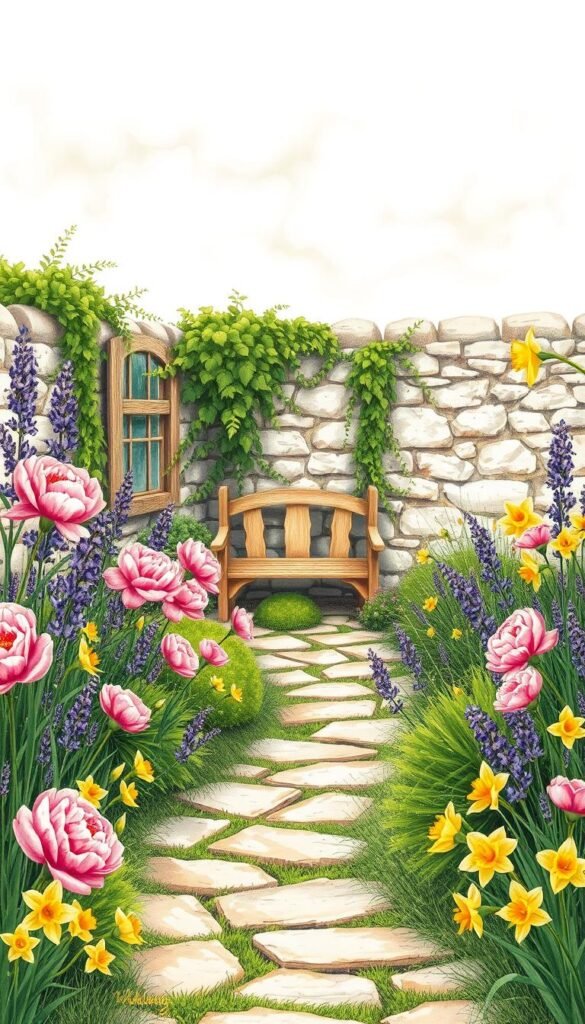
Charting your green sanctuary begins with purpose. Ask yourself: Will this space feed your family, heal scrapes, or dazzle with bouquets? Pollinators need homes too—will your blooms become their favorite diner? These answers shape every inch of your layout.
Essential Tools and Materials for Garden Design
Grab three trusty allies: graph paper, a 25-foot tape measure, and colored pencils. Landscape designer Elena Carter advises, “A sharp pencil reveals what blurry ideas hide.” Add a soil pH tester—most flowering plants thrive in slightly acidic ground (6.0-6.5).
| Tool | Purpose | Pro Tip |
|---|---|---|
| Circular template | Marking shrub zones | Trace pot bottoms for perfect circles |
| Waterproof notebook | Outdoor brainstorming | Press leaves between pages |
| String & stakes | Visualizing bed edges | Use cinnamon sticks as natural markers |
Creating a Functional Sketch That Balances Beauty and Use
Start by shading areas needing privacy or sun protection. Let your herb spiral anchor the design, with pollinator patches radiating outward. Leave 18-inch walkways between beds—wide enough for wheelbarrows but cozy enough to feel enveloped by greenery.
Color-code your sketch: blue for herbs, pink for cut flowers, green for veggies. This visual cheat sheet helps spot overcrowding before you dig. Remember, that dill plant will triple in size by July—give it breathing room now to avoid tangles later.
Plant Selections for a Cottage Garden: Perennials, Annuals, and More
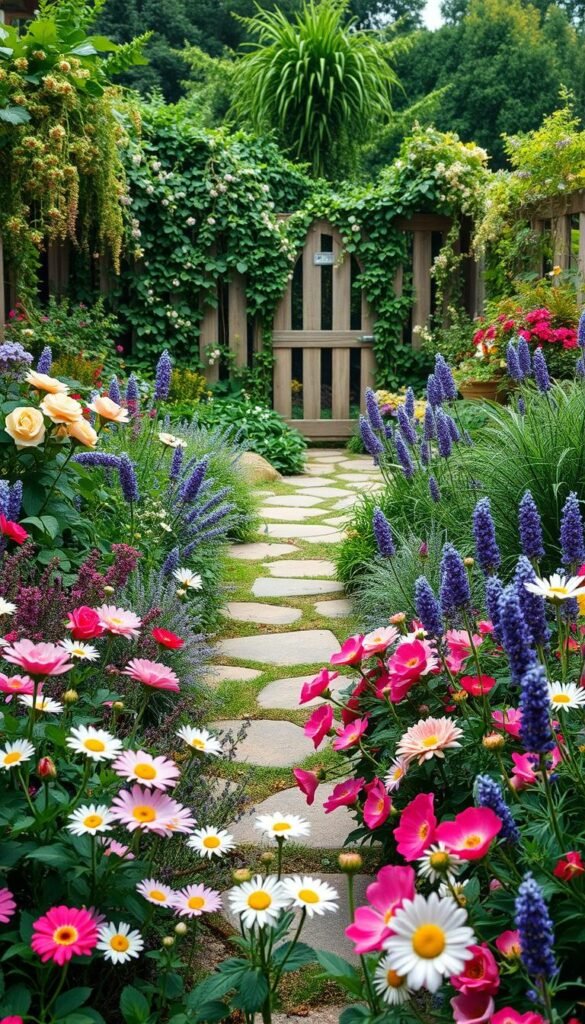
Crafting a living tapestry of color and texture begins with smart plant choices. Your selections should work overtime—offering beauty, fragrance, and practical uses while attracting pollinators. Let’s explore how to layer greenery that delights the senses and serves your needs.
Triple-Duty Herbs for Home & Health
Transform ordinary beds into apothecaries and kitchens. Lavender doubles as a calming tea and natural moth repellent, while lemon balm brightens salads and soothes stress. For skincare, damask rose petals make luxurious facial toners—simply steep in witch hazel.
Medicinal powerhouses like marshmallow thrive in sunny spots. Their roots create soothing salves for dry skin. Need first-aid plants? “Motherwort stops minor bleeding fast when crushed,” notes herbalist Gina Torres. Always research safe usage before trying new remedies.
Vertical Drama and Year-Round Structure
David Austin climbing roses transform fences into fragrant walls. Pair them with clematis for staggered blooms from spring to frost. For instant impact, anchor corners with dinnerplate dahlias—their bold forms command attention.
Flowering shrubs like camellias offer evergreen structure. Weigela’s pink spring blooms give way to burgundy fall foliage, proving beauty needn’t be high-maintenance. New to greenery? Our beginners’ checklist simplifies plant care basics.
| Plant Type | Star Performers | Key Benefit |
|---|---|---|
| Vertical | Delphiniums | Sky-high color spikes |
| Focal | Peonies | Massive scented blooms |
| Shrub | Hydrangeas | Season-long flowers |
Seasonal Maintenance: Keeping Your Garden Vibrant Year-Round
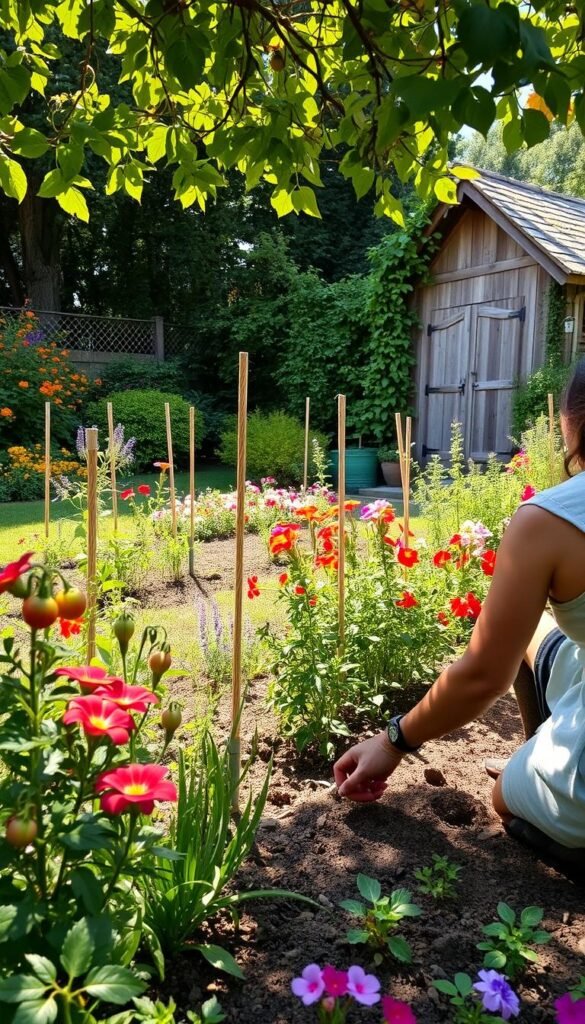
Your green oasis thrives when you sync with nature’s calendar. Embrace the ebb and flow of growth cycles to create a space that dazzles in every season while demanding less effort. The secret? Letting your greenery dance to its own rhythm.
Spring Planting and Summer Care Routines
As temperatures rise, focus on dividing crowded perennials. Sharing extra clumps with neighbors spreads joy and keeps your beds healthy. Tuck new additions into gaps, ensuring their roots touch moist soil. “A little chaos here creates charm,” says master gardener Lila Chen. “Let blooms spill onto walkways—it’s nature’s confetti.”
Summer brings thirsty roots and spent flowers. Water deeply twice weekly, targeting mornings to reduce evaporation. Snip faded blossoms to redirect energy into fresh growth, but leave some for seed-loving birds. A quick trim keeps pathways navigable without stripping that wild, romantic vibe.
Fall Cleanup, Winter Pruning, and Plant Division Tips
When leaves turn gold, resist the urge to tidy everything. Seed heads feed finches, while hollow stems shelter overwintering bees. Cut back only diseased foliage, leaving ornamental grasses swaying for winter drama.
Dormant months are perfect for reshaping shrubs and fruit trees. Use sharp shears to remove crossed branches, improving air flow. Dig up overachievers like mint or bee balm—their divided roots become instant starters for spring swaps or new beds.
| Season | Key Tasks | Pro Benefit |
|---|---|---|
| Spring | Divide perennials | Free plants + healthier growth |
| Summer | Deadhead flowers | Extended blooming period |
| Fall | Leave seed heads | Wildlife support |
| Winter | Prune woody plants | Stronger spring growth |
By working with natural patterns rather than against them, you’ll cultivate a resilient space that matures beautifully. Your reward? More time sipping lemonade among the blossoms than wrestling with weeds.
Budget-Friendly Tips for a High-Impact Cottage Garden
Creating a lush oasis doesn’t require endless funds—just smart strategies. Focus on working with nature’s patterns to achieve full, vibrant blooms without breaking the bank. The trick lies in balancing density with thoughtful spacing, letting each greenery thrive while maintaining that wild charm.
Smart Spacing for Thriving Greens
Start by researching your plants’ mature sizes. Leafy greens like spinach need 4-6 inches between stems, while basil sprouts can cluster 2-3 per hole initially. Use string to mark root zones on your soil before planting—this visual guide prevents overcrowding as seedlings grow.
Mix tall sun-lovers with low-growing shade-tolerant varieties. Dwarf tomatoes or compact zinnias add pops of color in tight spaces. For vertical interest, try pole beans climbing through ornamental grasses. Our guide to space-saving gardening offers more clever solutions for small areas.
Trim strategically—remove only leaves blocking airflow or sunlight. Let rambling nasturtiums spill over paths, their edible flowers softening edges naturally. Remember: controlled chaos creates that authentic cottage magic while keeping your green haven healthy.

